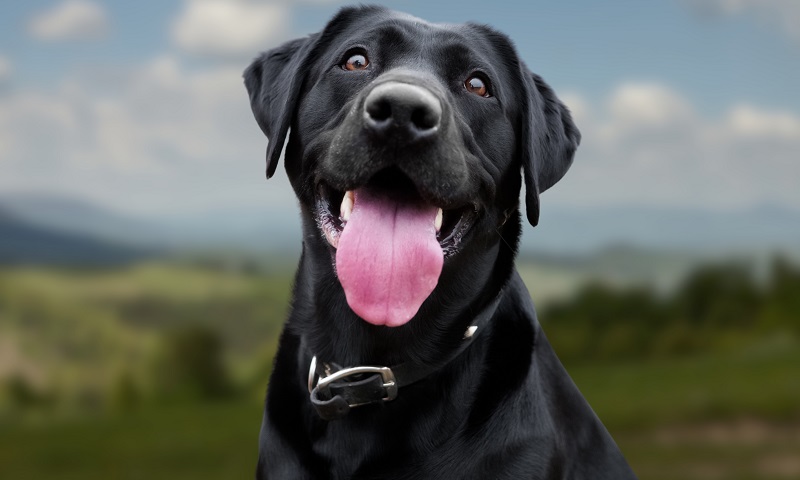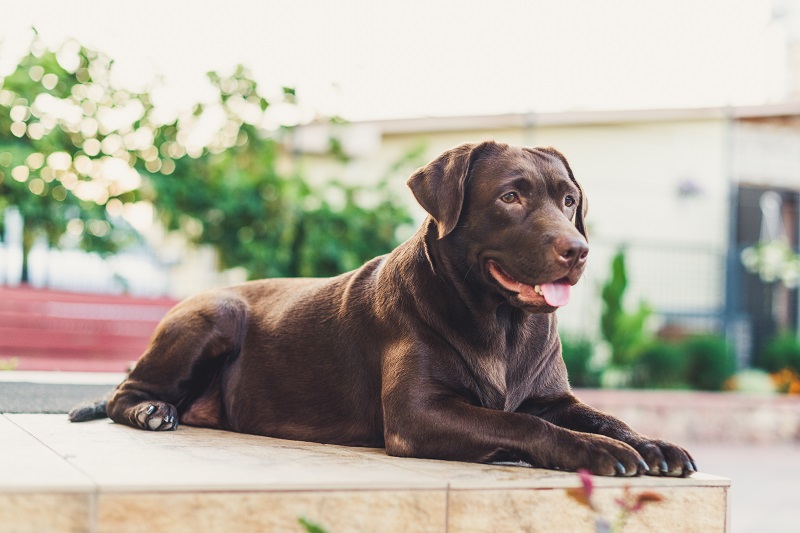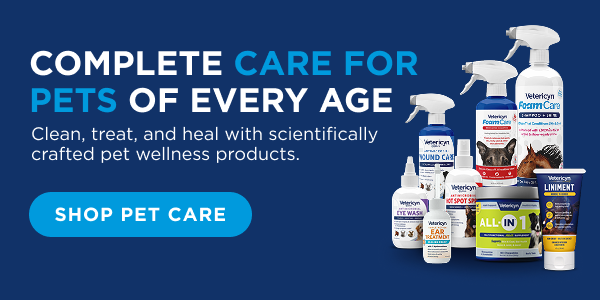Updated Aug 27, 2025
Labrador Retrievers have long been known as America’s best friend, boasting the American Kennel Club’s most popular dog breed for a record three decades.1
These friendly pooches of Canadian origin are often referred to as “light-switch dogs,” because they are eager to join you in whatever you want to do, whether it’s a challenging hike or snuggling up to watch a movie.
Perhaps second only to their enthusiastic temperament, Labs are most famous for their silky, shiny fur. If you’ve ever pet a Lab, you’ll know that their double coats are densely packed. If you’re in the market to adopt one of America’s sweethearts and you know about their lush coat, you may wonder: Do Labrador Retrievers shed?
We’ll explain how Labs got their coats, whether or not Labrador Retrievers shed, and what you can do to manage Labrador shedding.
The Original Wetsuit: A History of Lab Coats
There’s a reason your Lab’s coat is so thick and luscious, and it’s not merely a component of his dashing good looks.
Originally bred as a friend to fishermen for catching ducks and runaway fish, it’s unknown why these traditional waterdogs of Newfoundland bear the name of another nearby Canadian region (Labrador).2 When standardizing the breed’s physical traits in the late 19th Century, British breeders sought to honor Labradors’ original purpose.
Labs’ short, dense, double coats are weather-resistant and waterproof,3 making them ideal for Canadian winters (as opposed to longhaired retriever breeds, who would often emerge from the water encrusted with ice).
Their coats’ outer layer, or topcoat, is made of long, coarse hairs, is slightly oily in texture, and repels dirt and water.9 The thick, soft inner layer, or undercoat, works to keep them warm in cooler temps and traps cool air to keep them comfortable in hotter temps.9 Even Labs’ thick, tapered “otter tails” were designed with a purpose: to work as a “rudder,” aiding in faster turns while swimming.
Today, your family Lab might not be fishing, but he probably loves the water and can withstand long bouts of cold temperature. And even on a leisurely swim in your neighborhood lake or pond, there’s still nothing cuter than that “otter tail” in action.
How Much Do Labrador Retrievers Shed?
While your Lab’s delightfully soft double coat is an homage to his heritage, it also guarantees more Labrador shedding to manage.4 Your dog’s cottony undercoat, in particular, will shed quite a bit around the time the seasons change.9
You might notice extra shedding onto your dog’s comb (or your groomer’s) around these transition times. Labs shed in handfuls, so brush them every day during peak shedding times as part of their regular grooming, especially before a bath, in order to remove loose hairs.5
Does This Mean I’m Allergic to Labs?
It’s worth noting that Labs’ fluffy coats and tendency to shed don’t necessarily make them more allergenic for those allergic to dogs.6 People are not allergic to a dog’s fur itself, but rather to proteins in dead skin cells (aka, dander), saliva, and urine.6 Since all dogs have dander, all dogs have the potential to incite allergies.6 This means that even a hairless dog may be allergenic. People with significant allergies to pets should consider smaller breeds with single coats, according to experts.6 Dogs with thicker coats mean more grooming but all breeds, regardless of haircoat, may cause allergies.

A Fresher Fluff: Tips to Manage Shedding
As long as you’re prepared, managing your Lab’s shedding will be a breeze. It requires a few adjustments to your Labrador Retriever’s routine. Taking these grooming steps to minimize shedding will benefit your pup’s skin and coat health.7
Grooming Routine
During peak shedding season, typically the fall and spring months, as dogs’ bodies prepare for winter and summer, your Lab’s coat will need a little extra TLC.
Brushing every day is ideal, but at least three to four times a week will help manage shedding. Brushing sessions should last about five to ten minutes. Regular brushing softens your pet’s coat and reduces shedding.
Shedding season may call for extra baths for your pup. If you can squeeze them in, weekly baths are ideal. During the winter and summer months, bathing your dog two to three times per month will suffice.
Brush your Lab before her bath, in order to remove loose hair; then shampoo her under warm water. Remove loose hairs that may have inadvertently gotten into the eyes or ears. Check her eyes for any signs of irritation, and finally, dry her ears completely.8 Once your pup is completely dry, brush her one more time.
At-Home Grooming Tools
Whether grooming your dog at home or maintaining their coat between professional grooming sessions, a few at-home grooming essentials are a worthy investment.
You might need to try a few different types of brushes to find one that suits your dog’s specific coat, but a wide-toothed comb or a brush with metal- or plastic-tipped wire pins will likely work best for Labs’ short-but-thick coats. For Labs whose fur is particularly thick, consider trying a brush or dog undercoat rake made specifically for de-shedding.8
Another brushing method for short-haired dogs involves brushing with a stiff bristle brush, followed by a slicker brush.8 The bristle brush preps the loose hair by dislodging it, then the slicker brush gently pulls it out.
When bathing your pup at home, the right shampoo is essential to prevent additional shedding, Labrador Retriever skin problems, dryness, and flakiness. Look for a shampoo without artificial colors. Choose a product with natural ingredients like:
- Oatmeal
- Chamomile
- Olive extract
- Lavender
- Aloe extract
These will help restore your pup’s skin’s natural oils and maintain a healthy pH balance.
While a quality brush and shampoo are paramount, you might want to consider expanding your home grooming kit with a few additional items, including:
- Thick, absorbent towels
- A cool-air hair dryer (or even a canine-specific hairdryer)
- Canine toothpaste and a canine toothbrush
- Disposable dental wipes
- Veterinary ear-cleaning solution
- A grooming table (an outdoor picnic table will do, too)
- A tub for bathing (you can also use your own tub or shower)
- A canine Dremel (nail clipping tool)
With these tools on hand, you’ll never find yourself in a pinch between grooming appointments (or even dental checkups).
Supplements and Diet
If you’re concerned that your Lab’s shedding has become excessive, consult your vet. Certain dietary adjustments might help. Some vets recommend omega-3 and omega-6 fatty acid supplements to support healthy skin. These supplements will not stop your pet’s shedding completely — which is a good thing, as it’s a necessary process — but will encourage shedding in faster bursts, shortening the shedding duration.8
In general, a high-quality, balanced diet will help keep your pup’s skin and coat healthy. Check the ingredients of his daily food to ensure it includes those crucial omegas as well as biotin, a skin-and-coat-healthy B-vitamin. Check with your veterinarian to ensure you are feeding a well-balanced dog food.
Health Conditions That Spur Shedding
If you’ve taken all these steps and still notice excessive shedding, an underlying Labrador Retriever health issue may be the culprit. Ask your vet if your Lab’s excess fur loss may be the result of:
- Sensitivities to fleas, ticks, or other external parasites
- Environmental allergens
- Food allergies or a poor diet
- Local or systemic infections
Always check with your veterinarian about skin and haircoat issues, like excessive shedding, with your dog.

Control the Coat with Vetericyn
Friends to ancient Canadian fisherman and now beloved family pets worldwide, Labs have won us over with their eager, industrious personalities, and their beautiful layers of rich, soft fur.
While that gorgeous coat does shed, it’s manageable with a bit of planning and preparation. By following a shedding-season grooming routine and consulting your vet about dietary adjustments, you can give your pet the gift of a “light-switch” coat to match his demeanor.
Vetericyn is here to help with your shedding season journey. Our ALL-IN supplements act like a daily multivitamin for dogs, containing shedding-friendly omegas and biotin, as well as other holistically coat-healthy ingredients like carrot and amla fruit powder.
And beyond fur and skin, they may boost your Lab’s health, with additional natural ingredients like collagen, ashwagandha, and probiotics.
Vetericyn’s Foam Care Shampoo is pH-balanced, hypoallergenic, and washes off clean and easy. It’s aloe leaf and other ingredients help ensure your pup’s skin is hydrated and soothed.
Shedding season doesn’t have to be a hassle. With Vetericyn’s help, your Lab will boast a full, shiny coat worthy of Labradorian (or maybe Newfoundland) waters come season’s end.
 Reviewed by Dr. Kathy Adamson
Reviewed by Dr. Kathy Adamson
Dr. Kathy Adamson earned her bachelor’s degree from the University of Notre Dame and her Doctor of Veterinary Medicine degree from the University of Wisconsin-Madison School of Veterinary Medicine.
She completed a one-year small animal medicine and surgery internship at the North Carolina State College of Veterinary Medicine. Alongside her studies, Kathy worked in a research lab, contributing as an author and co-author to various journal articles.
She has also pursued medical writing and editing certification through the University of Chicago Graham School. Currently, she runs KMA Veterinary & Medical Writing, a freelance medical writing company, serves as the Digital Content Manager for the Greater Chicago Area Chapter of the American Medical Writers Association, is a member of the AMWA Communications Committee, and enjoys writing about healthcare topics for people and their cherished pets.
![]() https://www.linkedin.com/in/kathyadamsondvm/
https://www.linkedin.com/in/kathyadamsondvm/
Sources:
- American Kennel Club. Why Labs Are One of America’s Most Popular Dogs. https://www.akc.org/expert-advice/dog-breeds/why-labradors-popular/
- American Kennel Club. Labrador Retriever. https://www.akc.org/dog-breeds/labrador-retriever/
- ASPCA Pet Insurance. Labrador Retriever. https://www.aspcapetinsurance.com/resources/labrador-retriever-facts/
- American Kennel Club. What is a Double Coat, and What Dog Breeds Are Double-Coated? https://www.akc.org/expert-advice/dog-breeds/double-coated-dog-breeds/
- American Kennel Club. How to Groom a Labrador Retriever. https://www.akc.org/expert-advice/health/how-to-groom-a-labrador-retriever/
- Northwestern University. Fido Fact or Fiction: The Truth About Hypoallergenic Pets. https://www.helix.northwestern.edu/2009/05/19/fido-fact-or-fiction-the-truth-about-hypoallergenic-pets/
- Texas A&M University. Brushing Up for Shedding Season. https://vetmed.tamu.edu/news/pet-talk/reduce-dog-shedding/
- The Ohio State University. Shedding Season is Early This Year. https://u.osu.edu/pets/2017/05/03/shedding-season-is-early-this-year/
- American Kennel Club. Double-Coated Dogs: What the Double-Coat Does for Breeds. https://www.akc.org/expert-advice/dog-breeds/double-coated-dog-breeds/. Published August 24, 2023. Accessed August 18, 2025.
